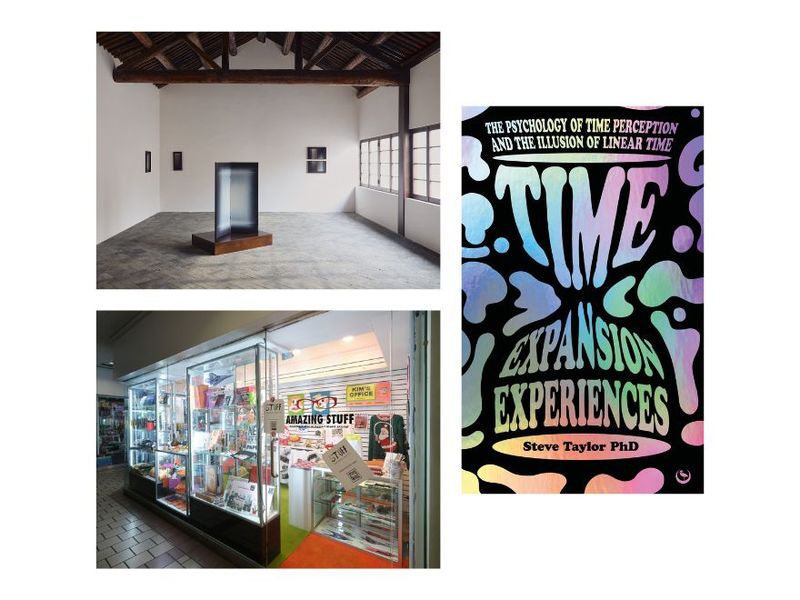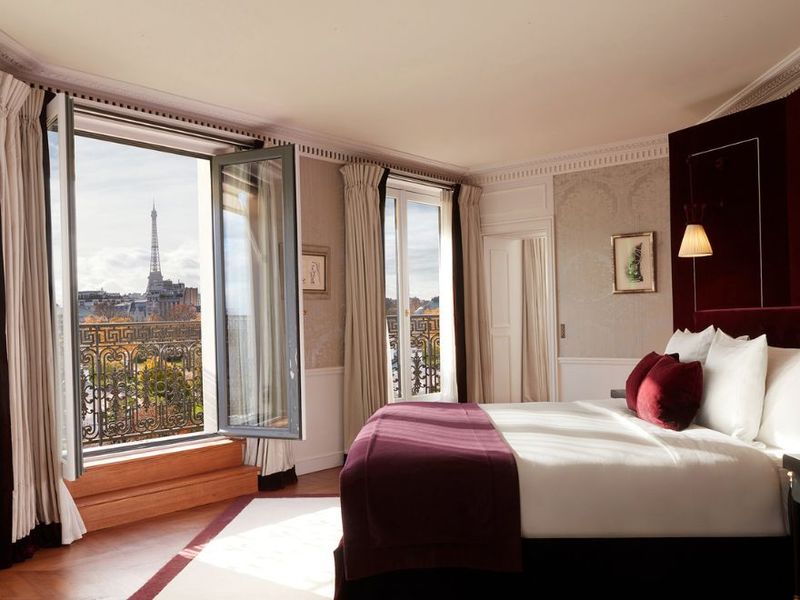In this week’s newsletter, we pay a visit to Malcolm Gladwell at the Pushkin Industries outpost in Hudson, New York; expand our sense of time with psychologist Steve Taylor’s mind-altering new book; check in at the sumptuous La Réserve Paris hotel; and more.
Good morning!
Next year marks 25 years since the release of Malcolm Gladwell’s The Tipping Point, which was, culturally speaking, a metamorphic book—and one that, ironically enough, marked a tipping point in Gladwell’s own career. Since then, he has gone on to write seven more best-selling books, including Blink (2005), Outliers (2008), and David and Goliath (2013), as well as dozens of stories for The New Yorker; launch the popular Revisionist History podcast, in 2016; and co-found, with Jacob Weisberg, the podcast and audiobook publisher Pushkin Industries, in 2018. This fall, Gladwell released his latest book, a sort of sequel to The Tipping Point, called Revenge of the Tipping Point: Overstories, Superspreaders, and the Rise of Social Engineering (Little, Brown and Company).
At the beginning of this month, I drove up to Hudson, New York, to interview Gladwell for the latest episode of Time Sensitive—our year-ender and the finale of Season 10—from the very studio where he records Revisionist History. There, I wanted to dig into his impressive trajectory and, given his deep research and historical analysis on so many subjects, from McDonald’s french fries, to “the world’s most perfect memorial,” to triplicate prescriptions, to understand his take on time. What emerged was a refreshing view I did not necessarily expect: Gladwell prefers not to think about the future. “Everyone has a different strategy for managing the kind of inevitable anxieties that come from being a human being,” he told me. “Mine is just not to live in the future.”
My favorite part of the conversation, if I could pick one, was about criticism and praise. While Gladwell has not been without his critics—including Anand Giridharadas, who recently, in a snippy New York Times review, likened Gladwell’s writing to fast food—he is also a beloved, widely praised author who’s known for bridging overlooked or little-considered links across history and time, and, if anything, getting people to think more deeply about important issues they might otherwise have brushed over. I’ve long appreciated Gladwell for his rare sleight-of-hand ability to turn stories into magical puzzles. Because of his approach to research, reporting, and writing, he manages to take certain under-the-radar ideas, often from the academic realm, and leap-frog them into popular culture.
Sure, Gladwall sits in this “middlebrow” zone that seems easy for many to pooh-pooh, but actually, by taking readers for a ride in the ways that he does, he makes seemingly esoteric subjects or phenomena entertaining and more widely accessible. Does this make the work lesser-than or inconsequential? I don’t think so, and book sales have long suggested otherwise. As he puts it on Time Sensitive, “This notion that if something is accessible, it is somehow less worthy of intellectual acclaim, I just think is nonsense,” before going on to cite the fiction of John Grisham, who has more than 50 bestsellers to his name. “Grisham’s novels are about real things,” Gladwell says. “They’re about the death penalty, they’re about corruption… After you’ve read a whole bunch of them, you’re like, ‘Oh my goodness, this guy has been one of the leading moral voices in America for almost two generations now.’”
I hope you enjoy our conversation. I think it’s safe to say that, for the past 25 years, Gladwell has been—and remains today—one of the leading voices in America. Dare I say this episode might mark a tipping point?
—Spencer
“Expectations are a burden and wherever possible should be abandoned.”
Listen to Ep. 125 with Malcolm Gladwell at timesensitive.fm or wherever you get your podcasts

“A Frame Within” at Space of Time Gallery
During the yearlong preparation for her inaugural exhibition in China, the Swedish artist Ylva Carlgren visited Beijing multiple times in search of connections to her interest in emptiness and in-between spaces. In researching traditional Chinese gardens and temple architecture, she discovered an Eastern philosophy that resonated with her work: the idea that an empty space can serve as a pathway leading to another space beyond. In “A Frame Within,” on view through Feb. 15, 2025, at Space of Time Gallery in Lisui Village, on the outskirts of Beijing, Carlgren presents a series grounded in this concept, centered on the techniques of monotone watercolor applied with a repetitive brushstroke motion, the removal of paint layer by layer—an inversion of the traditional painting process—and the setting of frames within other frames as a way of redefining space. What Carlgren has composed is an experience that subverts the usual dynamics of 2-D and 3-D space, inviting the viewer to reconsider the way they interpret their surroundings.
Time Expansion Experiences (Watkins Publishing)
At various points in our lives, we’ve all experienced certain nebulous, ungraspable moments of time—situations such as car accidents, in which time seems to slow down, or states of deep meditation, in which time appears to stretch radically or disappear altogether. In his new book, Time Expansion Experiences: The Psychology of Time Perception and the Illusion of Linear Time (Watkins Publishing), the psychologist Steve Taylor delves into his research on these phenomena, or what he has dubbed “time expansion experiences” (TEEs) and “time cessation experiences” (TCEs), respectively. Through his findings from hundreds of case studies on various experiences—mystical, psychedelic, near-death—he comes to the groundbreaking conclusion that TEEs and TCEs are real altered states of consciousness rather than a trick of recollection. His analysis unveils profound implications, perhaps above all that our widely held perception of time as linear is but an illusion.
“Amazing Stuff: Holiday Cultural Department Store!” at Whaam!
Porcelain drippy candle sticks from Ted Mueling, Yamakas from the apparel company Old Jewish Men, dolls and Christmas ornaments from Aurel Schmidt, ceramics from Bobbi Menuez—all these items and more stock the shelves of “Amazing Stuff: Holiday Cultural Department Store!,” curated by Paper magazine co-founder and “cultural troublemaker” Kim Hastreiter (the guest on Ep. 18 of Time Sensitive) at Whaam! gallery on New York’s Lower East Side. Open Tuesday to Sunday through Dec. 29, the shop is an ode to the veteran editor’s eclectic collection of objects, as well as to her forthcoming book, Stuff (Damiani), to be released next March. Other trinkets and tchotchkes for sale include items by Sky High Farms (whose founder, the artist Dan Colen, has also been a guest on Time Sensitive), Kenny Scharf, Kim Gordon, Stephen Sprouse, Maira Kalman (yet another Time Sensitive guest), and Michael Stipe. Bob Ross–style painting classes will be held at the shop all day tomorrow, Dec. 22, with all paintings on show at Whaam! in the days proceeding.

To come upon the fire engine–red door of La Réserve Paris hotel is to experience the tingly sensation of entering a fairy tale. For the hotel’s interior designer, Jacques Garcia—also responsible for sister properties in Ramatuelle, France, and Geneva, and L’oscar London, among many other sumptuous spaces—red symbolizes blood, and therefore life. The color appears in many guises throughout this 40-room property, the smallest of Paris’s 12 “palace” hotels, a distinction bestowed by the French government based on aesthetics, historical value, service standards, and gastronomy.
Inside, an astonishing world inspired by masterpieces of art and architecture unfolds, with La Réserve welcoming each guest through the hotel’s Louis XV Salon, modeled by Garcia on the Grand Salon of Napoleon III apartments at the Louvre—from its gilded ceiling cornices embellished with angels to its central round banquette upholstered in a scarlet floral damask. Amidst this formal grandeur, owner Michel Reybier had Garcia add framed Reybier family photos atop an ornate console inherited from Reybier’s grandmother. More of these intimate tableaus adorn the walls on the upper five floors, adding a personal touch that reinforces Reybier’s philosophy—manifest across all four La Réserve hotels, including at its Philippe Starck–designed Zurich location—of making guests feel as if they have been invited to stay in one of his homes.
In 2012, the French entrepreneur bought this Eighth Arrondissement hôtel particulier, as grand, single-family Parisian townhouses used to be called. It’s a surprisingly discreet setting, given its location just steps from the heavily fortified French presidential palace, the touristy Champs-Élysées, and the couture houses along Rue du Faubourg Saint-Honoré and the Avenue Montaigne. Built in 1854, in the Second Empire style of Baron Georges-Eugène Haussmann—the architect celebrated for reimagining modern Paris—for Napoleon III’s half-brother, Charles Auguste Louis Joseph, Duc de Morny, the six-story building hosted friends that the duke invited to parties at the then exclusive establishments along the Champs-Élysées. Reybier purchased the mansion from the estate of the fashion designer Pierre Cardin, then hired Garcia and the architect Bach Nguyen, who oversaw the structural restoration and modern additions including an underground floor. The extensive, three-year renovation employed more than 120 artisans, some borrowed from the Louvre’s ateliers, and required 250 tons of marble and nearly 20,000 feet of fabric. The resulting La Réserve Paris debuted in 2015.
All 15 rooms and 25 suites are lavishly outfitted in silk damask walls, velvet drapery, gilt-framed mirrors, and the Point de Hongrie herringbone parquet floors that emblematize Paris, and the hotel’s signature fragrance—a subtle mélange of cedar, mahogany, and patchouli—wafts throughout. Back near the hotel’s entrance sits the two-Michelin-starred fine dining restaurant Le Gabriel, an elegant, formal space made comfortable and contemporary with embossed leather walls and an abstracted leopard-spot carpet designed by Garcia. Elsewhere in the hotel, guests will continue to discover secrets, semi-hidden like Easter eggs, including the hushed, subterranean spa with a 52-foot-long heated pool—a rarity in Paris. Walls lacquered candy-apple red lead to a hammam, a trainer-staffed fitness studio, and three treatment rooms. To each guest who stays at this exquisitely run hospitality operation, one thing quickly becomes abundantly clear: La Réserve Paris is a dream come true.
This is a condensed and edited excerpt of a text by our editor-at-large, Cynthia Rosenfeld, published in the new book Design: The Leading Hotels of the World (Monacelli), with editorial direction by The Slowdown.
Our handpicked guide to culture across the internet.
Writer and strategist Colin Nagy shrewdly makes the case for how, while “something broken in luxury hospitality … an interesting counter-movement has emerged: the resurgence of family-owned hotels” [Why Is This Interesting]
The above-mentioned Kim Hastreiter recently launched a Substack newsletter called More Stuff, which is, as she describes it, “a weekly peek backward at three pivotal decades of cultural chaos” [More Stuff]
Journalist Jonah Weiner and design scout Erin Wylie unpack why the notion of “timeless style” is bogus [Blackbird Spyplane]
Deana Haggag (whom we spoke with on our At a Distance podcast back in the early days of Covid, in June 2020) has been promoted to program director for arts and culture at the Mellon Foundation—the largest supporter of the arts and humanities in the United States—where she will now oversee arts grantmaking [Mellon Foundation]
Berlin-based electro-classical musician and composer Nils Frahm’s newly released live Paris album is a mellowed-out masterpiece [Spotify]
